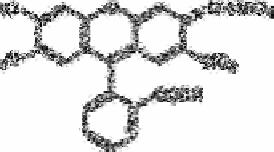Chemistry Reference
In-Depth Information
solvent orange
2.2 dihydroxy-4'4-benzophenone method
Afghan and Ryan [431] have described an automated fluorometric method employing 2.2
dihydroxy-4
′
4-benzophenone which is capable of performing analyses at a rate of 20
samples per hour and has a detection limit of 5µg L
−1
nitrate. The automated procedure
incorporates steps to overcome interference by high concentrations of chloride, sulphide
and humic acid substances.
Preparation of column to remove organic matter
The XAD-2 column consists of 15cm×0.32cm id glass tubing packed with Amberlite
XAD-2 polymeric adsorbent. The glass tubing was plugged at one end with glass wool
and an N-6 nipple was butted against the plugged end using a ½in length of ½in id Tygon
tubing for sleeving. A short length of Technicon ½in id transmission tubing was attached
to the nipple and fitted with a hosecock. The other end of the column was connected to a
65mm filtering funnel using in id Tygon tubing. The column assembly was secured in
a vertical position and filled with distilled deionised water, making sure no air bubbles
were trapped below the funnel and hosecock. A washed aqueous slurry of the resin was
poured into the funnel and packed into the column by draining water through the bottom
of the column. The funnel and Tygon tubing were removed from the top of the column.
The N-6 nipple assembly completed with the transmission tubing and hosecock was filled
with distilled deionised water and forced over the opening of the column, making sure
that no air bubbles were trapped inside. The column was then inserted while running the
manifold as shown in Fig. 2.27.
Fig. 2.28 shows uncorrected excitation and emission spectra of 2.2
′
-dihydroxy-4; 4
′
-
dimethoxybenzophenone and its reaction product with nitrate under similar experimental
conditions as for Fig. 2.27. The sensitivity of the reaction was also compared with similar
concentrations of quinine sulphate.
Excitation was carried out at 380nm and emission at 445nm. The fluorescence
development did not take place in a medium containing less than 70% sulphuric acid. The
sensitivity and the concentration range where the response was linear varied with the
concentration of sulphuric acid. A maximum fluorescence was obtained between 83-86%
sulphuric acid. Nonlinear calibration curves were obtained when the ratio of sulphuric




Search WWH ::

Custom Search